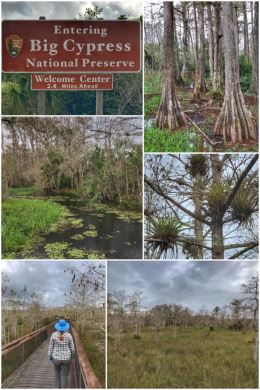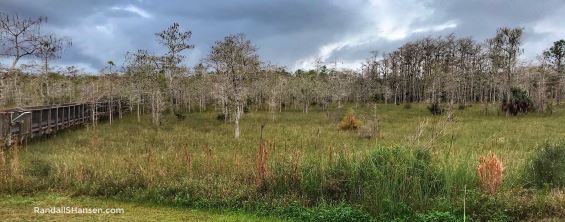
We stopped in Naples in southwest Florida so that we could spend some time exploring what some consider should be the fourth national park in the state… Big Cypress National Preserve, established in 1974. This 729,000-acre preserve protects the freshwaters of the Big Cypress Swamp — which is essential to the health of the neighboring Everglades National Park — while also supporting the rich marine estuaries along Florida’s southwest coast. It is also home to the endangered Florida Panther (which lives in pinelands, tropical hardwood hammocks, and mixed freshwater swamp forests; males can cover a range of 236 square miles). Sadly, only about 5 percent of the panther’s original habitat remains wild because of creeping development.
The land within the preserve was originally suggested to be part of Everglades National Park, but the area was eliminated to help the park gain its status. The difference with the preserve is that it allows multiple uses, including drilling for oil (which began in the 1940s and continues today).
Big Cypress Swamp Preserve has five unique habitats: Hardwood Hammocks, Pinelands, Prairies, Cypress Swamps, and Estuaries.
The preserve has two information centers — the Oasis Visitor Center (on the east side) and the Big Cypress Swamp Welcome Center (on the west side) — both open daily, with informational exhibits, gift shop, and informative film. Both also offer parking spaces for RVs, but they are limited — and in both parking lots we found inconsiderate car owners hogging the RV spaces.
The Oasis Visitor Center is the southern terminus of the Florida National Scenic Trail (managed by the U.S. Forest Service), one of 11 National Scenic Trails, which runs 1,300 miles up to the Gulf Islands National Seashore (near Pensacola) on the Florida Panhandle. We love these trails — which offer permanent non-motorized recreation opportunities for hiking and other activities. (Other designated scenic trails which we have hiked include the North Country Trail, Appalachian Trail, Pacific Crest Trail, Pacific Northwest Trail, and Continental Divide Trail.)
We visited the Big Cypress Swamp Welcome Center, where we watched the movie, bought a magnet, chatted with a ranger, and wandered around before traveling east to a fun 1-mile (RT) boardwalk hike at the Kirby Shorter Roadside Park.

The real adventures in the area, though, were the ones in the combo-package we purchased from Captain Jack’s Airboat Tours (located in Everglades City, about 35 miles southeast of Naples) — including two airboat rides and a swamp buggy ride.
We started with a 1-hour mangrove airboat tour, which delivered lots of fun as we floated along through twisting mangrove tunnels, sometimes slowly and sometimes with speed. These boats are fairly small and only hold about six people — which made it easy to interact with the captain as he shared stories, folklore, history, and fun animal facts. During the tour, we stopped several times looking at waterfowl; we also stopped in an area where there once was a railroad built in the swamp. The Deep Lake Railroad was built in 1913 by Walter Langford and John Roach, who operated a grapefruit grove near Deep Lake (a natural sinkhole located in Big Cypress, with a depth of 90 feet, making it one of the deepest lakes in Florida), and used the railroad to ship citrus down to Everglades City and beyond. The line was abandoned in 1957.

We then traveled about 5 miles up to Wooten’s Everglades Airboat Tours, located in Ochopee, where we enjoyed the other two parts of the combo ticket. The Wooten’s airboat tour uses a bigger boat (holding up to about 15 people) and is a shorter ride (lasting about 30 minutes) through part of the 259 wetland acres the company owns.
While the ride was billed as a grasslands tour, most of it went through more mangrove areas than grassland. Our captain told us the reason for the change was because more saltwater was coming up into what was once freshwater, with the mangroves (which like coastal saline or brackish water) taking over where the saltwater killed off the grass. Before visiting the everglades, we had pictured the whole area as a massive river of grass, but have since learned the importance of mangroves — which are widely present in the coastal channels and winding rivers of the everglades — and serve multiple beneficial roles.

After we finished the airboat tour, we crossed the road for the third part of the combo. Our final tour was on the swamp buggy, which easily manages on land, deep mud, and wetlands… traveling mostly through a cypress forest on a 30-minute adventure. (A swamp buggy has powerful tractor tires and an open, elevated platform with seating for up to 20 people.) We saw deer, more waterfowl, an alligator, a manatee, and a teenage Florida Black Bear — a subspecies of the American Black Bear that lives throughout Florida and southern portions of Alabama, Georgia, and Mississippi. The tour driver was our favorite of the three — not only fun and informative, but stopping often and showing us photos of some of the things he was discussing.
Wooten’s also has an “animal sanctuary” that includes more than 100 alligators, as well as crocodiles, river otters, and turtles. For some strange reason, it also has two tigers and two lions. Their Animal Sanctuary & Alligator Park also includes an Alligator Show, which is fairly entertaining. Overall, though, we just felt sad for most of the animals living in fairly small pens and ponds — and especially for the tigers and lions. (To be fair, an article claims they are upgrading facilities from zoo-like to animal sanctuary; also, the lions and tigers were adopted from previous private owners unable to maintain their upkeep.)
One final comment about the area. We loved seeing all the “air plants,” epiphytic plants (such as orchids and bromeliads) that co-exist, living in the trees of the swamp. These plants have evolved to receive all the nutrients they need from rain, sun, and airborne particles. Can you tell we absolutely love nature and the amazing power and beauty of the natural areas throughout the land? We MUST protect these natural areas — for our survival and the survival of this Earth… and for future generations.
Before leaving Naples and continuing our exploration north along the Gulf Coast of Florida, we did another quick stop at a Costco Wholesale (Costco #354) for gas and groceries — making it at least the 50th we have shopped at while on this trip!
